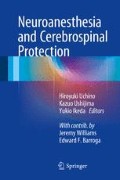Abstract
Awake craniotomy was introduced for surgical treatment of epilepsy a long time ago and has subsequently been used in patients undergoing surgical management of supratentorial tumors, arteriovenous malformations, and deep brain stimulation (Pasquet, Curr Res Anesth Analg 33(3):156–164, 1957). Awake craniotomy aims to maximize lesion resection while sparing important foci, particularly the so-called eloquent areas such as the motor, somatosensory, short-term memory, and language areas (July et al. Surg Neurol 71:621–625, 2009). Several new techniques have recently been developed for anesthetic management in awake craniotomy.
Access this chapter
Tax calculation will be finalised at checkout
Purchases are for personal use only
References
Pasquet A (1954) Combined regional and general anesthesia for craniotomy and cortical exploration. II. Anesthetic considerations. Curr Res Anesth Analg 33(3):156–164
July J, Manninen P, Lai J, Yao Z, Bernstein M (2009) The history of awake craniotomy for brain tumor and its spread into Asia. Surg Neurol 71:621–625
Wada J (1949) A new method for the determination of the side of cerebral speech dominance. A preliminary report of the intra-carotid injection of sodium amytal in man. Igaku to Seibutsugaki 14:221–222
Piccioni F, Fanzio M (2008) Management of anesthesia in awake craniotomy. Minerva Anesthesiol 74:393–408
Guideline Committee of the Japan Awake Surgery Conference (2012) The guidelines for awake craniotomy. Neurol Med Chir 52:119–141
Lobo F, Beiras A (2007) Propofol and remifentanil effect-site concentrations estimated by pharmacokinetic simulation and bispectral index monitoring during craniotomy with intraoperative awakening for brain tumor resection. J Neurosurg Anesthesiol 19:183–189
Silbergeld DL, Mueller WM, Colley PS, Ojemann GA, Lettich E (1992) Use of propofol for awake craniotomies. Surg Neurol 38:271–272
Manninen PH, Balki M, Lukitto K, Bernstein M (2006) Patient satisfaction with awake craniotomy for tumor surgery: a comparison of remifentanil and fentanyl in conjunction with propofol. Anesth Analg 102:237–242
Bekker AY, Kaufman B, Samir H, Doyle W (2001) Use of dexmedetomidine infusion for awake craniotomy. Anesth Analg 92:1251–1253
Costello TG, Cormack JR, Hoy C, Wyss A, Braniff V, Martin K, Murphy M (2004) Plasma ropivacaine levels following scalp block for awake craniotomy. J Neurosurg Anesthesiol 6:147–150
Tongier WK, Joshi GP, Landers DF, Mickey B (2000) Use of the laryngeal mask airway during awake craniotomy for tumor resection. J Clin Anesth 12:592–594
Skucas AP, Artru AA (2006) Anesthetic complications of awake craniotomies for epilepsy surgery. Anesth Analg 102:882–887
Herrick IA, Craen RA, Gelb AW, Miller LA, Kubu CS, Girvin JP, Parrent AG, Eliasziw M, Kirkby J (1997) Propofol sedation during awake craniotomy for seizures: patient-controlled administration versus neurolept analgesia. Anesth Analg 84:1285–1291
Berkenstadt H, Perel A, Hadani M, Unofrievich I, Ram Z (2001) Monitored anesthesia care using remifentanil and propofol for awake craniotomy. J Neurosurg Anesthesiol 13:246–249
Blanshard HJ, Chung F, Manninen PH, Taylor MD, Bernstein M (2001) Awake craniotomy for removal of intracranial tumor: considerations for early discharge. Anesth Analg 92:89–94
Author information
Authors and Affiliations
Corresponding author
Editor information
Editors and Affiliations
Rights and permissions
Copyright information
© 2015 Springer Japan
About this chapter
Cite this chapter
Ishida, T., Kawamata, M. (2015). Anesthesia in Awake Craniotomy. In: Uchino, H., Ushijima, K., Ikeda, Y. (eds) Neuroanesthesia and Cerebrospinal Protection. Springer, Tokyo. https://doi.org/10.1007/978-4-431-54490-6_33
Download citation
DOI: https://doi.org/10.1007/978-4-431-54490-6_33
Publisher Name: Springer, Tokyo
Print ISBN: 978-4-431-54489-0
Online ISBN: 978-4-431-54490-6
eBook Packages: MedicineMedicine (R0)

